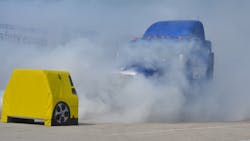The trucking industry has another acronym to get familiar with: FCAM, for forward collision avoidance and mitigation. The National Highway Traffic Safety Administration (NHTSA) on Friday will publish a notice stating the agency plans to evaluate FCAM technology with an eye toward a heavy-duty equipment mandate. A petition for such a rulemaking was submitted in February by the Truck Safety Coalition, the Center for Auto Safety, Advocates for Highway and Auto Safety, and Road Safe America.
“In work zone areas and when traffic is significantly slowed or at a complete stop, cars are particularly vulnerable to being rear ended by large trucks,” John Lannen, executive director of the Truck Safety Coalition said at the time the petition was submitted. “Trucks are overrepresented in fatal highway crashes, and they are even more so in fatal work zone crashes. This is why it is imperative that F-CAM technology is required safety equipment in large trucks.”
The petitioners claim that FCAM systems have the potential to provide significant safety, economic, and societal benefits, citing estimated safety benefits from a 2012 research study conducted by the University of Michigan Transportation Research Institute (UMTRI).
For several years, NHTSA has been conducting research on heavy vehicle FCAM technologies, the agency notes. Based on this research, the NHTSA agrees that FCAM systems have the potential to save lives by preventing or reducing the severity of rear-end crashes.
Truck and safety-systems manufacturers are rolling out the next generation automatic emergency braking systems for truck tractors, designed for improved performance that warns the driver and will automatically brake in response to stationary vehicles and objects in the road ahead.
"This is a positive event as NHTSA will continue to move forward with research that builds awareness for, and reinforces the value of these technologies to help mitigate crashes and save lives; something that many fleets today who have adopted collision mitigation systems already understand," Fred Andersky, director of government and industry affairs for Bendix Commercial Vehicle Systems, tells Fleet Owner. "It is still important, however, to keep in mind that these are driver assistance technologies, not driver replacement technologies. The driver is and will continue to be an integral part of the overall fleet safety equation."
Andersky discusses the latest Bendix CVS safety technologies here.
Similarly, integrated safety technology company Meritor WABCO reports a reduction in rear-end collisions of as much as 87% for customers who use the OnGuard collision mitigation system, as well as an 89% reduction in the cost of rear-end crashes not prevented.
“This NHTSA initiative is an incredibly positive step that mirrors the direction of the commercial vehicle fleet thought leaders,” says Stephen Hampson, president and general manager of Meritor WABCO. “This initiative would benefit the entire driving community in saving lives, reducing injuries and mitigating property damage."
There are a number of terms being used by industry and regulators for FCAM technology, including forward collision warning (FCW), crash imminent braking (CIB), dynamic brake support (DBS), automatic emergency braking (AEB), and collision mitigation braking (CMB), NHTSA points out. For the purpose of potential rulemaking, the FCAM technologies are the systems that combine FCW alert signals with CMB automatic braking capability.
In May, the Commercial Vehicle Safety Alliance (CVSA) submitted a letter supporting the petition for rulemaking and recommended that the mandate for FCAM systems apply to vehicles with a GVWR of 10,001 pounds or more (rather than 10,000 pounds or more as requested) to better conform to existing commercial motor vehicle safety classes.
And in the June report on a highly publicized rear-end collision involving a Wal-Mart Transportation tractor-trailer and a luxury coach carrying actor Tracy Morgan and others, the National Transportation Safety Board (NTSB) outlined the life-saving benefits of currently available collision avoidance systems (CAS), and the watchdog agency recommended the latest technology to be made standard.
Also in June, NHTSA announced electronic stability control (ESC) systems will be required on large trucks and buses beginning in 2017.
The pre-publication announcement regarding the FCAM petition is here.




